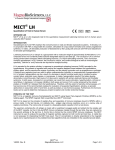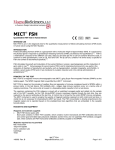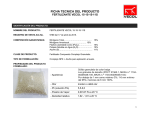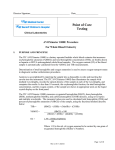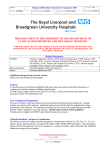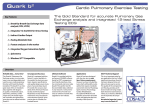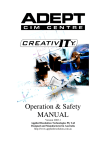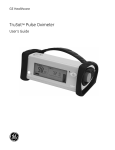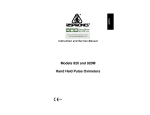Download GEM OPL - Massachusetts General Hospital
Transcript
POCT Program Massachusetts General Hospital - Pathology Service 55 Fruit Street, Boston, MA 02114 Title: GEM OPL Procedure Cross References: Gem OPL Initial Training and Assessment Record Gem OPL Competency Documentation - 6 month and annual Gem OPL Corrective Action Log Gem OPL Instrument Replacement Log MGH POCT Inter-Laboratory Correlation Procedure POCT Proficiency Testing Procedure POCT Proficiency Testing Evaluation Worksheet Contents: Purpose ................................................................................................................................................................... 2 Scope ...................................................................................................................................................................... 2 Policy and Procedure Statement ............................................................................................................................. 2 Test Principle........................................................................................................................................................... 2 Proficiency Testing .................................................................................................................................................. 2 Regulatory Requirements........................................................................................................................................ 3 Competency Assessment........................................................................................................................................ 4 Critical Elements...................................................................................................................................................... 4 Limitations and Interferences .................................................................................................................................. 4 Test Kit/Supplies/Equipment ................................................................................................................................... 5 Calibration ............................................................................................................................................................... 5 Calibration Verification/Correlations ........................................................................................................................ 5 Quality Control Monitoring ....................................................................................................................................... 6 Specimen Collection................................................................................................................................................ 7 Patient Test Procedure............................................................................................................................................ 7 Instrument Replacement / Major Maintenance........................................................................................................ 9 Reference Ranges................................................................................................................................................... 9 Technical Support.................................................................................................................................................... 9 References .............................................................................................................................................................. 9 Cross-References ................................................................................................................................................... 9 Written by: Paul Pappagianopoulos Date: 6/1/2005 Updated by: Paul Pappagianopoulos Date: 07/12/2010 Reviewed/Approved by: Kent Lewandrowski, MD Date: 9/30/2010 Title (with LTR): GEM OPL Procedure (LTR17672) Last Approved: Gregory, Kimberly (Electronic Signature Timestamp: 4/22/2014 7:55:10 PM) 1 Purpose This document outlines policies and procedures that deal with Total Hemoglobin and %O2Hgb testing. In an effort to be concise some information may be excluded from the manufacturer’s recommended procedure. It is recommended that operators familiarize themselves with the manufacturer’s product information that accompanies each package and their manual if one exists. Scope Level of Personnel: Pulmonary Function & CPET Technicians Testing Site: Pulmonary Function CCU Laboratory Policy and Procedure Statement The Gem OPL is a moderately complex instrument that performs definitive whole blood analysis of total hemoglobin concentration, oxyhemoglobin fraction and the oxygen content. These analytes are measured using specific and multiple wavelengths to obtain results. Physicians may give a verbal order for oxygen saturation measurement. Reasons may include, but are not limited to: Cardiac output calculation (FICK) ASD, VSD, PFO studies Verification of arterial/venous access Respiratory compromise Test Principle The total hemoglobin concentration measured by the Gem OPL includes oxy-, deoxy-, met-, and carboxyhemoglobin: [THb] = [HbO2] + [Hb] + [MetHb] + [HbCO]. Similarly, the percentage of oxyhemoglobin reported by the Gem OPL is the so-called fractional saturation: [HbO2] • 100 %O2Hb = [HbO2] + [Hb] + [MetHb] + [HbCO] The oxygen content of the sample is [O2] = 1.39•THb•%HbO2 / 100, if dissolved oxygen is ignored, THb is expressed in g/dl, and [O2] is expressed in ml/dl. No sample preparation is required. Analysis is quickly accomplished by injecting the sample into a disposable cuvette and inserting the cuvette into the instrument. The Gem OPL then illuminates the sample with multiple wavelengths, records the optical density of the sample at each of the wavelengths, and computes the results. In less than 10 seconds, the oxyhemoglobin fraction, the total hemoglobin concentration, and the oxygen content of the sample are shown in appropriate units on the liquid-crystal display on the front panel. Proficiency Testing The College of American Pathologists (CAP) sends unknown samples to the laboratory for analysis several times per year. Results are submitted to the CAP within 10 days of survey receipt. If a site fails 2 out of 3 events or two consecutive events, according to federal law, it may be required to discontinue testing. All Survey results are to be handled and reported in the same manner as clinical results following the directions on the CAP Survey package insert. The samples are not to be analyzed in duplicate unless clinical specimens are analyzed in duplicate. Actions or decisions must be documented. Title (with LTR): GEM OPL Procedure (LTR17672) Last Approved: Gregory, Kimberly (Electronic Signature Timestamp: 4/22/2014 7:55:10 PM) 2 Participation must be random and not assigned to specific individuals. Successful participation may be used as demonstrating successful competency for that year. Upon receiving the survey: The POCT program will contact the participating departments regarding the survey and the timeline of the survey to be performed. The departments must be available within the period identified by POCT. The Key operators must make sure of the following: o o o o o Instruments are in good working order. Randomly select staff to participate. Maintain original CAP survey form with the results documented. Maintain the signed Attestation form. In addition, retain copies of above in the files of testing personnel. Once results are obtained, they should be reported to CAP via mail, fax or electronic entry on the CAP website. Site Director and CLIA certificate Director or designees shall review survey results to assess performance and ensure compliance with the standard and comment. Scores of 100 % minimally requires documentation of review by the Director or designee. Scores between 100% and 80% requires a comprehensive investigation and remedial action documented of unsuccessful challenges. Scores less than 80% requires a comprehensive investigation and documentation of remedial action of unsuccessful challenges. Scores of less than 80 percent may jeopardize a sites ability to continue to perform testing. Should a site fail proficiency, they will be required to immediately perform a comprehensive investigation and document remedial action. Operator re-training may be required. In order to avoid cessation of testing a site failing a challenge will be expected to develop and implement a more aggressive plan for performance improvement. Each site is responsible for completing survey challenges when they arrive. Anticipated Survey Periods: SO (Oximetry) Product Receipt Evaluation Receipt April May July August October November Regulatory Requirements I. Each testing site must have a documented quality control program, which is developed in collaboration with or has been approved by the MGH Pathology Service. II. All test results must be maintained in patient records with all required information for four years Required information: 1. Patient’s name 2. Medical Record Number 3. Patient’s gender 4. Patient’s age or date of birth 5. Date & time test collected, performed and reported Title (with LTR): GEM OPL Procedure (LTR17672) Last Approved: Gregory, Kimberly (Electronic Signature Timestamp: 4/22/2014 7:55:10 PM) 3 6. 7. 8. 9. 10. 11. Ordering Physician Responsible physician (if not 6) Reference or Target Range Test Performed Test units Lab name III. Additional information that must be retained for four years: 1. Testing personnel records 2. Quality control results 3. Product information (i.e. serial number, lot numbers, expiration dates, etc.), information on quality control and any remedial action 4. QC charts, maintenance sheets, reference and critical ranges IV. Other: 1. Universal precautions must be observed when handling any patient specimen. 2. A physician’s order or standing order is required is required prior to performing test. 3. The Hospital Hand Hygiene policy must be adhered to at all times. V. Linearity/ Calibration Verification The testing site will perform and document linearity/calibration verification checks every six months. Competency Assessment All operators must read the procedure manual and complete the “Operator Training Checklist” after initial training. For Total HGB and %O2Hb, the competency assessment process is done following initial training, at 6 months during the first year, then annually thereafter. Competency is assessed using six methods, examples of which are below: 1. Successful performance of routine patient testing, verified by direct observation 2. Supervisor monitoring of the recording and reporting of test results 3. Supervisor review of intermediate test results, QC, proficiency tests, and preventative maintenance performance 4. Successful performance of instrument maintenance function checks and calibration, verified by direct observation 5. Testing previously analyzed samples, proficiency testing samples, or internal blind testing samples. 6. Assessment of problem-solving skills Expired Operators: Operators that fail to meet competency requirements within 365 days will be locked out of the system. They will be required to undergo retraining and competency assessment according to above. Critical Elements 1. Never re-use a test cuvette once it has been inserted into the analyzer. 2. Do not remove the syringe from the cuvette until testing is complete. 3. Discard cuvette with trapped air bubbles and check for blood clots from patient specimen prior to injection. 4. A delay in analysis of greater than 30 seconds may yield erroneous results. 5. Air bubbles will yield erroneous results. If any air bubbles are present in the light pathway, discard cuvette. 6. Overfilling of the testing cuvette is a common source of error. This action will cause blood to cover the optics window inside the instrument and affect results. Contact the IL Tech Support 1-800-678-0710 if contamination is suspected. Limitations and Interferences Title (with LTR): GEM OPL Procedure (LTR17672) Last Approved: Gregory, Kimberly (Electronic Signature Timestamp: 4/22/2014 7:55:10 PM) 4 1. The Gem OPL is validated for the range of %O2Hb from 5.1 to 100%. The THb is validated from 5.1 to 21 g/dL. Samples with results outside of these ranges should be confirmed with a repeat sample. 2. An incorrect THb value will be obtained if the correct pathlength for the cuvettes in use is not entered into the Gem OPL. Test Kit/Supplies/Equipment Product Cuvettes Vendor IL Manufacturer # IL 06320480100 People Soft# 145866 Storage RT tightly sealed Optical QC filters Yellow and Orange Level-1 CO-Oximeter control Level-2 CO-Oximeter control Level-3 CO-Oximeter control IL Contact vendor 53117 53118 53119 RT IL IL IL *Instrument serial number specific IL 3313250 IL 3314250 IL 3315250 CO-Oximeter calibration verification controls Syringes 1 ml RNA Medical RNA CVC 223 131546 RT (12 months) 2 - 8ºC (36 months) RT (12 months) 2 - 8ºC (36 months) 2 - 8ºC (18 months) BD 309602 08653 RT Calibration As the Gem OPL employs highly stable state-of-the-art light sources, it does not need to be re-calibrated frequently. The Gem OPL easily maintains its calibration for five or more years. A. Cuvette Pathlength (THb calibration): Each time a new bag of cuvettes is put into use, the pathlength value of the cuvettes must be entered into the Gem OPL. The procedure is as follows: 1. Press the Main Menu key, and select Option 1 to reach the calibration menu. 2. Select Choice 3 on the calibration menu. 3. When prompted to do so, enter the pathlength value on the bag of cuvettes currently in use into the Gem OPL. 4. After confirmation that the value entered is correct, the instrument will store a new calibration constant in non-volatile memory and use it in subsequent analyses. Calibration Verification/Correlations Calibration verification must be performed: 1. Every six months by using RNA CVC 223 kit 2. If there is any major maintenance or replacement of any critical parts that may influence test performance. 3. Instrument replacement 4. Control results indicate that there may be a problem with the test system. Results will be entered into the online program available from RNA Medical to provide a report on the linearity and calibration verification of the Gem OPL along with peer comparison. Results for the calibration verification will be reviewed and approved by the POCT Site Coordinator and the Medical Director. Failure of any parameter will require an investigation and possibly re-calibration of the instrument. Patient sample correlations may be performed if required. Correlations between the Gem OPL and the Avoximeter are performed every six months. Title (with LTR): GEM OPL Procedure (LTR17672) Last Approved: Gregory, Kimberly (Electronic Signature Timestamp: 4/22/2014 7:55:10 PM) 5 Quality Control Monitoring Daily: Two QC filters are provided for verification of the calibration of the instrument. Automatic QC lockout requires that both filters be run every 8 hours of patient testing and electronically documented in IMPACT. Filters are serial number specific and may only be used with assigned instrument. The following QC results should fall within the following ranges: Yellow QC filter Orange QC filter THb 7.8 to 8.2 g/dL 16.7 to 17.3 g/dL %HbO2 93.7 to 96.3% 37.8 to 40.2% Running a QC filter: 1. Insert one of the QC filters into the Gem OPL. 2. Enter your Operator ID into the instrument as requested. 3. Document results on QC log sheet. Patient testing should not be performed if any one of the four QC values is out of range. Any values out of range may indicate dirty optics. The optics should be cleaned according to the manufacturer’s directions (see ‘Troubleshooting Section’ in’ Operator’s and Service manual’). The QC filters must be repeated after cleaning the dirty optics. If the problem persists, contact the IL Tech Support 1-800-678-0710. Weekly: Three levels of liquid QC are performed weekly to verify calibration of the system. 1. Follow hand hygiene protocol and use gloves. 2. Enter your Operator ID number using the numeric keypad and press ENTER. 3. Shake the control sample Level 1 according to the manufacturer's recommendations, approximately ten seconds. 4. Restore liquid to the bottom of the ampoule with gentle tapping. If foam or small bubbles are present, allow ampoule to stand until these have come to the surface. 5. With fingers protected, carefully snap open the ampoule. 6. Contents should be sampled as soon as the ampoule is opened. It is necessary to transfer liquid from the ampoule to a syringe. Use a 1 ml non heparinized syringe. Insert tip of syringe into the ampoule, lift the bottom of ampoule up and slowly draw liquid into the syringe without sample air. 7. Remove the syringe and insert the syringe tip into the cuvette syringe port on the cuvette and inject the QC sample holding cuvette down at a 45° angle. Inject QC material into the cuvette until the sample reaches the vent patch. Leave syringe attached to cuvette. Note: Over injection of QC material will cause the vent patch to bulge outward. If this happens, pull back slightly on the syringe plunger just until the patch flattens. 8. Check that no air bubbles are present in the sample light path. Note: Air bubbles will yield erroneous results. If air bubbles are present in the light pathway, discard cuvette. 9. Holding the cuvette by the black cap, gently insert it into the slot of the instrument's front panel. 10. Insert the cuvette within 30 seconds of filling it. Note: A delay of analysis greater than 30 seconds may yield erroneous results. 11. Quality Control data will be displayed. Data is saved electronically in Gem IMPACT. Note: If a result is outside of the range limits, this represents an unsuccessful quality control test. a. Verify that the Cuvette pathlength is correct for the cuvettes in use, b. Check the desiccant's indicator in the cuvette package, c. Perform the optical QC using the yellow and orange filters, d. Repeat the control with a new ampoule. If the results are within range, proceed with patient testing, e. If results are still outside of acceptable range limits, contact the IL Tech Support 1-800678-0710. f. Do not use instrument. 12. Discard the cuvette in an appropriate biohazard container 13. Repeat steps 1-10 for Level 2 & Level 3controls. Title (with LTR): GEM OPL Procedure (LTR17672) Last Approved: Gregory, Kimberly (Electronic Signature Timestamp: 4/22/2014 7:55:10 PM) 6 14. Data saved in Gem IMPACT. Specimen Collection Heparinized whole blood is used. The sample should be obtained from an arterial cath, an arterial puncture, venous cath or venipuncture. Sample should be labeled with two patient identifiers according to hospital policy. 1. Use appropriate precautions for handling possibly infectious blood. 2. Withdraw 10cc of blood into a syringe and discard. For a PA line, approximately 2cc of waste is necessary. Withdraw 0.5cc of blood for testing. 3. The required sample size for the Gem OPL is 50 μl. Prior to analysis the sample should be free of any air bubbles and mixed by rolling the syringe between the outstretched palms of both hands for 10 seconds. Invert the syringe and repeat mixing. Expel a small amount of blood sample into an absorbent surface. Care should be taken to prevent the introduction of air into the sample when it is drawn. Expel all air bubbles from the syringe and cap or seal the end of the syringe. Patient Test Procedure 1. Patient testing can only be done if all quality control results are within acceptable limits. 2. The instrument indicated that it is ready to analyze samples by displaying the following message: 3. Follow hand hygiene protocol and use gloves 4. Collect the blood sample in a heparinized syringe ensuring proper waste to avoid contamination. 5. Roll the syringe containing the blood sample between hands periodically inverting the syringe to mix the sample thoroughly. The sample must be mixed for a full ten-second interval just prior to injection into the cuvette. Note: Poorly mixed samples or those containing clots may cause inaccurate results. 6. Expel a small amount of sample from the syringe. 7. NEVER INJECT BLOOD INTO THE INSTRUMENT ITSELF. 8. Attach a disposable cuvette to the luer tip of the syringe, and inject the blood into the cuvette following the directions for Correct Cuvette Technique. Correct Cuvette Technique: a. Connect blood-filled, plastic syringe to a new disposable cuvette. b. Hold cuvette downward at a 45° angle and express blood into cuvette until sample fills cuvette up to the vent patch at the opposite end. CAUTION: Never force blood into cuvette. If cuvette does not fill easily, discard it and use another one. Title (with LTR): GEM OPL Procedure (LTR17672) Last Approved: Gregory, Kimberly (Electronic Signature Timestamp: 4/22/2014 7:55:10 PM) 7 c. Observing the cuvette closely, make sure that the light path at the widest portion of the sample chamber is completely filled with blood and that blood reaches the air vent at the opposite end of the cuvette. Note: Over injection of blood will cause the vent patch to bulge outward. If this happens, pull back slightly on the syringe plunger to flatten patch. d. Check that no air bubbles are present in the sample light path. Note: Air bubbles will yield erroneous results. If air bubbles are present in the light pathway, discard cuvette. e. If any blood is on the exterior surface of the cuvette, wipe it off with gauze. 9. Leaving the syringe attached to the cuvette, and holding the cuvette firmly by its black cap, insert the cuvette into the slot in the front panel of the instrument within 30 seconds of filling. Note: A delay in analysis of greater than 30 seconds may yield erroneous results. 10. Enter patient medical record number and press ‘Yes’. 11. Enter your 9 digit operator ID number (only valid operators are allowed to perform testing) and press ‘Yes’. 12. Observe the LCD display. Do not disturb the Gem OPL while it is busy. Within 10 seconds, the results will be displayed. 13. Withdraw the cuvette as soon as the sample has been analyzed. Data will stay on the display until the cuvette is removed. A printout of the results is available on the attached printer and data will remain in non-volatile memory until deleted. 14. To analyze the next sample, discard the previously used cuvette into an appropriate biohazard container, obtain a fresh cuvette from the box and repeat the process from step 1. Title (with LTR): GEM OPL Procedure (LTR17672) Last Approved: Gregory, Kimberly (Electronic Signature Timestamp: 4/22/2014 7:55:10 PM) 8 15. In the event of a test result that appears inconsistent with the patient’s clinical status, send a sample to the Stat ABG lab. Instrument Replacement / Major Maintenance A. The replacement instrument policy must be followed when: The instrument is removed for service Replaced by another instrument Returned to service B. Documentation: All the information should be documented concurrently on the “Gem OPL Corrective Action Log”. C. Before putting the analyzer into service: 1. 2. 3. 4. 5. 6. 7. Enter the cuvette pathlength of the currently used cuvette into the instrument, Perform QC by using the yellow and orange optical filters, Run three levels of liquid QC, Perform the Calibration Verification, Document the Cal Verification results on the RNA Medical sheet and enter into the web site, Document all steps performed on the “Instrument Replacement Log”. Send a copy of the calibration verification to the POCT program for review and approval by the POCT Director or designee prior to putting the analyzer into service. Reference Ranges A. Hemoglobin: Age Female g/dL Male g/dL 18 years 12 years 6 years 2 years 6 months 3 months 2 months 1 month 14 days 7 days 3 days 0 days 12.0-16.0 12.0-16.0 11.5-15.5 11.5-13.5 10.5-13.5 9.5-13.5 9.0-14.0 10.0-18.0 12.5-20.5 13.5-21.5 14.5-22.5 13.5-19.5 13.5-17.5 13.0-16.0 11.5-15.5 11.5-13.5 10.5-13.5 9.5-13.5 9.0-14.0 10.0-18.0 12.5-20.5 13.5-21.5 14.5-22.5 13.5-19.5 B. %O2hgb: Arterial: Mixed venous: 94-98 60-80% C. Courtesy critical values for hemoglobin: < 9 g/dl Technical Support Call Tech Support for questions or troubleshooting assistance at 800-678-0710. References Gem OPL Operator’s Manual, Instrumentation Laboratory CVC 223 Co-Oximeter Calibration Verification Controls package insert, RNA Medical, Devens, MA 1/06 Multi 4 Co-Oximeter controls package insert Levels (L1, L2, L3); Instrumentation Laboratory, Lexington, MA Cross-References Gem Gem Gem Gem OPL Competency Documentation - 6 month and annual OPL Instrument Replacement Log OPL Initial Training and Assessment Record OPL Corrective Action Log Title (with LTR): GEM OPL Procedure (LTR17672) Last Approved: Gregory, Kimberly (Electronic Signature Timestamp: 4/22/2014 7:55:10 PM) 9










